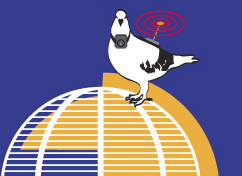|
The Pacific Rim Curatorial Workgroup is developing a pan-Pacific Rim exhibition, "Container Culture," as part of the overarching Pacific Rim New Media Summit for the ISEA2006 Symposium in San Jose, California, August 5-13, 2006. The exhibition will feature work by artists in the "catch basin" of the port city where the curator is located or working. It will use standardized shipping containers for presentation of this work. The shipping container is an index of the economic relationships that exist among otherwise culturally diverse Pacific Rim countries and will become a temporary zone of quotidian "white cube" galleries for unstable media placed in the very public context of the central Plaza Cesar Chavez in San Jose.
Container Culture: Curatorial Concept
One of the most significant examples of cross-cultural encounters in contemporary art is the traveling exhibition. The traveling art exhibition has often served to operationalize and exemplify the cross-cultural encounters and exchanges that are deemed ‘necessary’ and ‘natural’ in the globalized art world. However, the traveling exhibition is rarely this straightforward gesture in/of globalization as the cross-cultural encounters engendered by such exhibitions are complicated by a range of social, political, economic and art historical differences. The artists in traveling exhibitions are rarely able to respond to each new context through their works, and even if they do, these are usually minimal and therefore rarely responsive or responsible to the cultural encounters these exhibitions are meant to initiate. The traveling exhibition thus converts every new cultural context to an empty container for the art works to be merely placed in with some sensitivity at best to the exhibition site as physical location.
‘Container Culture’ is an exhibition of art works that travel from different port cities in Asia-Pacific in standardized containers to San Jose to be presented alongside each other; almost like a conference of containers. In an ironic reversal of the tendency of conventional traveling exhibitions to convert every new space into an empty container, this exhibition invites curators and artists from each of these port cities to convert a container into a culturally-specific space. The exhibition conceptually draws on and hopes to deliberate on some of the following notions:
a) Ports - as liminal spaces that have traditionally and still negotiate the relations between countries - and this draws on and elaborates a
whole set of related concepts of commerce, exchange values, customs procedures, border anxieties, legal trade vs illegal traffic, etc.;
b) Containers as Spaces- as instantiations that mimic the white cube as an empty 'container' even while potentially enabling the subversion of the white cube's immobility by their portability;
c) Transportation - the notion of artworks traveling in space and time between countries and hopefully bringing some of the culturally specific
elements of one place to another - and of course the related concepts of location, cultural specificities, speed, proximitiy and distance.
d) Networks. Transporting shipping containers from one port city to another maps a network of economic relationships. By specifically curating new media installations, Container Culture investigates the effect of virtual networks to create real cultural connections.
Some Issues to Deliberate on and Discuss at the Summit:
1. One of the original intents of this project was to enable a model for and instance of distributed curating where a single curatorial concept would be differently realized, locally presented and then subsequently travel or become connected to a final destination where the separate realizations of the concept would be presented side-by-side. However, the logistic difficulties and different funding levels of the projects in each city meant that several aspects of the original plan had to be abandoned. Despite the fact that we were not able to realize the original plan, the project as it has evolved is equally interesting. It will be useful then to begin to look at what other models of distributed curating could be evolved in the future. What are the peculiar challenges and possibilities of such curatorial projects? How does one negotiate the specificities of location in the development of such projects?
2. The original concept of the project also focused on engaging different aspects of the container – its vocabulary of standardization, its spatial restrictions and its portability. What are some of the specific ways in which some of the projects have engaged the specificities of containers as exhibition spaces?
3. An important decision in the project was where to place the containers. While the original idea was to place it in the Caesar Chavez plaza and exploit its openness and public accessibility, due to several reasons we could not use this space. We eventually are now working to show it in the South Hall – an interesting space that has the sense of a huge container albeit a differently shaped one. What are the strategies to work with temporary exhibition spaces? How do and should these spaces connect to the more permanent ones?
4. What are some of the curatorial issues of each of the containers? What are the issues and concerns of the various works in the containers from the different port cities? How do these works benefit from or resonate with the other works and containers in this exhibition?
Working Group Members:
Steve Dietz, Co-Chair, Director, ZeroOne San Jose: A Global Festival of Art on the Edge, Minneapolis, Minnesota, USA
Gunalan Nadarajan, Co-Chair, Associate Dean for Research and Graduate Studies Penn State University, College of Arts and Architecture, University Park, Pennsylvania, USA
Zhang Ga, Professor, New York Institute of Technology, New York, New York, USA
Deborah Lawler-Dormer, Executive Director, Moving Image Centre, Auckland, New Zealand
Alice Ming Wai Jim, Art Historian/Curator, Centre A, Vancouver International Centre for Contemporary Asian Art, Vancouver, British Columbia, Canada
Ellen Pau
Johan Pijnapple
Yukiko Shikatas
Soh Yeong Roh, Director, Art Center Nabi, Seoul, Korea
|
